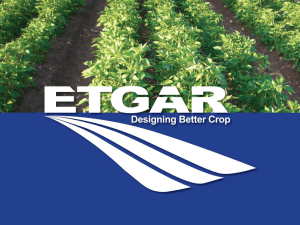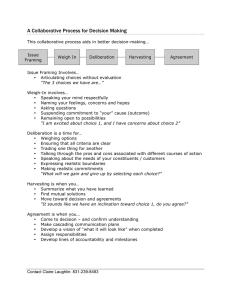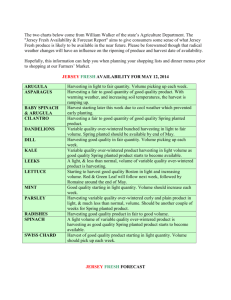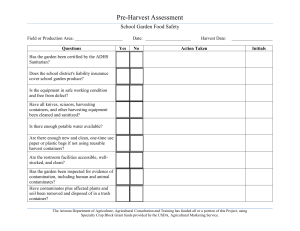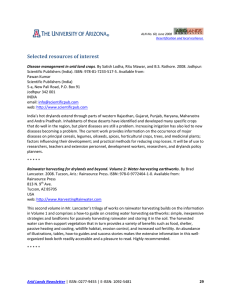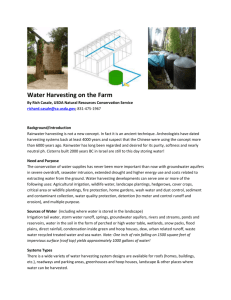by Short Term Cropping of Blackcurrants G
advertisement
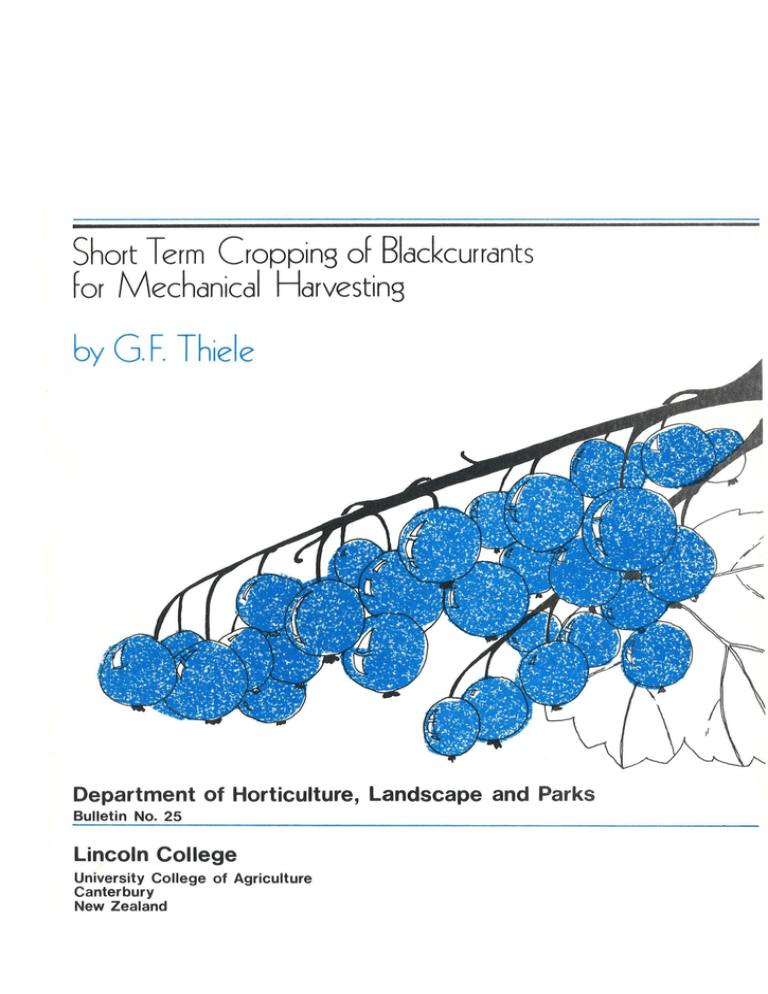
Short Term Cropping of Blackcurrants
for Mechanical Harvesting
by G .F. Thiele
Department of Horticulture, Landscape and Parks
Bulletin No. 25
Lincoln College
University College of Agriculture
Canterbury
New Zealand
SHORT TERM CROPPING OF BLACK CURRANTS
FOR MECHANICAL HARVESTING
G.F.
Thiele
Department of Horticulture,
Landscape and
Parks.
Lin co 1n Co 11 e ge
New Zealand
1979
SHORT TERM CROPPING OF BLACK CURRANTS
FOR MECHArnCAL
HARVESTING
Introduction
The Horticultural Research Centre, Levin, New Zealand established
the feasability of growing black currants on a high density system suitable
for mechanical harvesting. The prototype mechanical harvester developed
at the centre was subsequently further developed and researched by the New
Zealand Agricultural Engineering Institute at Lincoln to produce an effective
commercial machine.
Simultaneously, the Department of Horticulture at Lincoln College
developed a 1 hectare area of black currants to research the husbandry and
marketing aspects of commercial production on this intensive system and
to establish the economics of production and harvesting. This paper details
the results of this work.
Preliminary Work
The work at the Levin Research Centre used the variety Magnus
almost exclusively at an intra row spacing of approximately 15cm {6"}.
Close spacing produces an upright plant without pruning suitable for straddletype harvesting.
To determine the optimum intra-row spacing one row of each of the
varieties Goliath, Magnus and Cotswold Cross was established at spacings of
6", 9", 12" and 18" in the row with 8 1 between rows. With 4 replications
of each spacing per variety the trial covered 1/3 of an acre.
The yields for the six harvesters are summarised in Table 1. Year
1 harvest was taken approximately 16 months after establishment from cuttings
and the plants were sawn to within 15cm of .ground level immediately following
the sixth harvest. Regrowth was encouraged during the following season
to allow the cycle to continue. There was little significant difference
between the four spacings although during the earlier years the 9" {22.9cm}
spacing showed slightly higher yields in the 5th and 6th years. Overall
the yieid for the six years pointed to the 9" {22.9cm} spacing being the best.
2
SPACING TRIAL:
Table
Year
Year
Year
Year
Year
Year
BLACKCURRANTS
1:
1
2
3
4
5
6
70-71
71-72
72-73
73-74
74-75
75-76
Total Yield
equally.
15.2 cm
(6 n)
Yields tonnes/ha
30.5 cm
22.9 cm
(9" )
(12" )
2.1
5.6
7.5
14.7
8.3
6.4
2.5
8.8
7.2
15.5.
8.4
6.2
44.6
--
48.6
--
1.7
4.8
7.0
15.0
9.4
7.4
45.5
--
45.7 cm
(18" )
1.4
5.0
6.8
14.9
9.3
8.7
46.1
--
The type of bush produced by each spacing suited the harvester
There was no noticeable difference.
The yield recordings for the three varieties were not replicated
and could be subject to edge effects,for the outside rows Goliath and
Cotswold Cross. Variety yields summarised in Table 2 show little difference
between varieties. It was significant that the harvester removed Magnus
much more cleanly than the other two .\(arietie-s. Both Goliath, a large
berry and Cotswold Cross tended to tear slightly at the pedicil when
shaken from the bush and Cotswold Cross in particular tended to be removed
attached to the "strig" and in a mixed maturity condition. The application
of Ethrel 5-7 days prior to harvesting improved the sample.
Magnus consistently harvested one week earlier than the other
two varieties a significant point in extending the harvesting period for
machine operation.
3
VARIETY TRIAL:
Table 2
Year
Year
Year
Year
Year
Year
1
2
3
4
5
6
70-71
71-72
72-73
73-74
74-75
75-76
Total Yield
Gol i ath
2.3
7.0
7.0
15.8
8.4
6.6
47.1
--
BLACKCURRANTS
Magnus
1.7
4.4
7.4
12.8
9.3
7.5
43.1
--
. Cotswol d Cross
1.7
5.3
7.2
16.6
8.8
7.. 5
47.1
--
Commercial Area
Establishment
A one hectare area of blackcurrants was established in August 1971
to assess the economics of the short term cropping system on a commercial scale.
The cultural decisions made for this block were based to some extent on
previous results from the Levin Research Centre and the spacing trial and
to some extent on judgement.
The 1 hectare area consisted of 30 rows 5' 6" (approximately 1.7m)
apart alternating 3 rows of Magnus with 2 rows of Cotswold Cross, so that
the varieties were in the proportion of 0.6 hectares r·1agnus to 0.4 hectares
Cotswold Cross.
The intra-row spacing used was 6" (approximately 15cm).
Cuttings were taken in August from previous season's growth.
They were 23-25cm (approximately 9-10") in length inserted in the soil
through plastic 1 to about half their length. 2
1.
2.
Rlack plastic 45cm in width, 3~in thickness is suitable
Subsequent work suggests a longer cutting of 30 - 40cm (12-16") is
preferable.
4
Illustration 1 N.Z.A.E.I. machine workin g on the right.
It requires
1 driver and 2 sorters.
Illustrations 2 and 3 Blackcurrants on the catching platform (lef t )
and elevator (riqht) before debri s is blown and sorted clear.
5
Some cuttings were taken in June and stored upright almost covered
in damp sawdust before planting in August, in comparison with cuttings
selected and planted directly. Establishment results were:Stored cutti ngs
Direct planted cuttings
69.7%
90.7%
established
established
Use of plastic is an important factor in cutting e~tablishment
for moisture retention and suppression of weed growth. Trickle irrigation
was laid at the base of the cuttings on. the surface of the plastic with
micro jets at 60cm (2') intervals.
A clover sward was established soon after the cuttings were set
out by sowing a 3:7 mixture of red and white clover at 11kg per hectare.
Illustration 1 shows the block in its 2nd harvesting season with
the N.Z.A.E.I. machine working on the right .. The catching platform and elevator
of the machine are shown in illustrations 2 and 3.
Cultural Details
Fertil i ser:
Weed Contro1 1 :
Nitrophoska Yellow 600 kg/ha braodcast, Aug - Sept
3.4 l/ha Preglone.
Late dormant
2.0 kg/ha Simazine. Late dormant
Applied along the edge of the plastic and at the base of
cutti ngs if requi red.
Mowing
24 hours/ha/season
Disease and Pest Control:
1. Bordeaux Mixture
Late winter
All seasons oil
2. Metasystox
Thiodan
Pre f1 oweri ng
Benlate
3. Euparen
Post flowering
Phosdrin or
if required
------------------------~~~~~~~!~~---------------------------------------------1.
An application of 2,4,5,T for clover control is required in some seasons
along the edge of the plastic.
6
Cultural Details (cont)
Ripening Agent:
Irrigation:
Pruning
Ethrel applied 5-7 days prior to harvest. (1 l/ha)
(details of experimental work recorded on page Ii).
Applied regularly to keep the soil near soil capacity
pa~ticularly during the period Sept - Jan (see yield
figures Table 3 for comparison between trickle and
sprinkler irrigation.)
Nil apart from removal of broken branches.
Yields:
Table 3 summarises the yield.s over the five year life of the crop,
and Fig 1 demonstrates the pattern of production and the advantange of trickle
irrigation. First harvest was approximately 16 months after setting out of
the cuttings.
Yields are slightly lower than in the pilot trial but seasonal
conditions have an influence. The 1976 - 77 season was a very difficult
one. A frost during flowering caused an estimated 50% reduction in crop
and a very wet harvesting period caused uneven ripening and severe loss
from Botrytis cinerea, particularly in Cotswold Cross.
By year 5 the bushes were meeting between rows and it was impossible
to apply fungicide or ripening sprays from the ground. Aerial application
was attempted but the microclimate within the area precluded adequate control.
It was unfortunate that the area could not be retained for a sixth
harvesting season. Alternate rows were removed with a P.T.O. rotary slasher.
Yields in the sixth harvesting season with half the number of bushes
were:Trickle irrigation
Overhead irrigation
Magnus
3.18 t/ha
2.96 t/ha
Cotswold Cross
3.16 t/ha
2.76 t/ha
The comparison between trickle irrigation and overhead sprinkler is
not valid scientifically due to the absence of applied water data and lack
of replication. Nevertheless the clear cut superiority of trickle irrigation
for every recording, points to the importance of maintaining the soil near
soil capacity as it was with trickle, rather than applying water at 10-14
day intervals during dry periods with a sprinkler.
Fig.1
YIELDS (Tonnes/ha)
14 III Magnus
D Cotswold Cross
1 IiiiiJ Trickle .Irrigation
10 III Overhead Irrigation
~8
-f-J6
--
4
2
1
2
3
YEAR
4
5
8
As a result of the reduction in yield in the 5th year from
overcrowding an interrow spacing of 2.5m (8 1 ) is to be recommended.
BLACKCURRANT YIELDS:
1 HA
Table 3:
COMMERCIAL AREA
(tonnes / hectare)
Magnus
(trickle irrigation)
Magnus
(sprinkler irrigation)
Cotswold Cross
(trickle irrigation)
Cotswold Cross
(sprinkler irrigation)
Year 1
72-73
Year 2
73-74
Year 3
74-75
Year 4
75-76
Year 5
76-77
TOTAL
2.52
8.05
9.25
11.39
2.67
33.83
1.94
6.59
6.52
9.16
2.30
26.51
2.22
7.56
6.74
12.56
2.03
31.11
1.90
6.34
4.85
10.09
1. 76
24.94
Fruit Loss
The important factor to be considered in mechanical harvesting is
what crop can be harvested not the amount of crop not harvested or lost to
the ground.
Because the economics of the system are so dominated by yield,
any husbandry or machine modification which will reduce fruit loss needs to
be i nves ti ga ted.
Comparisons were made each season between machine and hand harvesting,
by hand harvesting randomly selected sections of rows throughout the block
and comparing these yields with similar lengths of machine harvested rows.
A summary of percentage loss over the first five years is given in Table 4.
Figures are the percentage of the hand harvesting yield lost with machine
harvesting. The quality of machine harvested fruit is clearly demonstrated
in illustration 4.
9
Il l ustration 4.
Fr uit mecha nically harvested (right) can cOlllmand a DremiullI of
up to 20c/kg over han d harvested fruit.
Illu st ration 5 .
Bushes orodu ced frolll
longer cut t i ngs at the
1st harvesting stage 16
months after estdblisrllllent' ,
10
BLACKCURRANT FRUIT LOSS WITH
MECHANICAL HARVESTING
Table 4:
(Percentage of hand yield)
Magnus
Cotswo1 d Cross
72/73
73/74
74/75
75/76
76/77
51%
22%
17
27.8%
25.4
25.7%
26 :8
46.3%
51.9
49
Most of the fruit in years 2, 3 and 4 was lost by missing the
catching platform in the centre of the row. Much of the loss in the 5th
year was due to the large size of the bushes and the 'brushingll of fruit
by the machine as it forced its way between the bushes meeting in the row.
As an example, the total loss over the 5 year period for trickle irrigated
Magnus was equivalent to 14.74 t/ha.
Cutting Trial
Because of the first year the fruit is carried well down on the
plant and there was clear evidence that much of the fruit within 15-20 cms
of ground level was being lost, a trial was laid down with longer cuttings.
Illustration 5 shows the bushes at the 1st harvest stage.
The cuttings were 40cm in length with approximately 15cm below
ground level, 15cm of clear stem (buds removed) above ground level and 10cm
with the buds retained at the tip of the cutting. Half of the bushes were
harvested by hand and half by machine. Unfortunately no comparison was made
with smaller cuttings and the results were therefore inconclusive.
Machine harvesting with Magnus resulted in 61.8% loss compared
with hand harvesting which was higher than the 1st year loss with smaller
cuttings in the commercial block.
Profile
harvesting by hand with Magnus showed the following profile.
11
Height from
Ground 1evel (cm)
o-
10
10 - 20
20 - 30
"> -30
% harvesting in
each band
o.
3.8
35.7
60.5
Although the results were inconclusive, the type of bush produced
with a 15cm "leg" logically suggests that this method of establishment should
be recommended. It is suspected that advantages will show when the bushes
are eventually sawn back to 15-20 cm aBove ground level at the end of year 5
or 6.
Modification of the catching mechanism on the harvester, (perhaps
using nylon brushes instead of rubber at the point where it meets the base
of the bushes) needs to be investigated in an endeavour to reduce the loss.
Use of Ethrel
The need to use a ripening agent seems to vary from season to
season according to weather conditions. In a warm dry season ripening
occurs evenly. In a cool moist season there is very uneven ripening and
expensive post harvest sorting has been necessary to produce a free flow
line of fruit up to export standard.
Results of Ethre1 applied at 120m1/100 litres (1 l/ha) 5 days
prior to harvest are given in Table 5. Clearly the first harvest is
increased, parti cu1 ar1y with Magnus but results vary markedly from season
to season.
More work is required in this area particularly regarding the
economics of application. The cost of Ethrel per hectare is approximately
$40. Extra sorting costs per hectare post harvest when Ethre1 is not
applied are normally 3-4 times the cost of application. Pending further
detailed recordings it is recommended that Ethrel be applied as standard
practice.
12
It has been the practice to harvest the crop with three passes
of the machine over a period of 7-10 days. Use of Ethrel may reduce the
requirement to two harvests.
USE
OF
ETHREL
Table 5:
PERCENTAGE
FIRST HARVEST
IN
Magnus
THREE
SEASONS
CotswoTd Cross
Year 1
Ethrel
No Ethre 1
54.5
45.3
23.9
21.4
Ethrel
No Ethrel
73.4
50.1
53.5
48.4
Ethrel
No Ethrel
71.3
51.1
71.4
51.9
Year 2
Year 3
Economic assessment
Any presentation on the economics of production of horticultural
crops is severely affected by variables. Detailed costs and returns have
been kept for the life of the crop but inflation, and interest rates have
increased rapidly during the period of study. Correction factors could
be applied and an historical net present value for the investment determined.
Furthermore the area of crop grown markedly affects the cost of lumpy inputs
such as the harvesting machine and freezer. Method of marketing, and hence
net price, and yield have the greatest effect on the economics of production.
Accordingly it has been decided to present a cash flow situation
for 1 hectare for the 7 year life of the crop, based on input and output
data recorded, using 1978 prices. This will provide the basis for modification
to fit any particular production situation.
13
Establishment
Establishment costs are presented in Table 6 and cash flow data
in Table 7. (Note the establishment year when no crop ·is harvested is
referred to as Year 0). Figure 2 compares gross income with direct
production, harvesting, and marketing costs for the 6 harvesting seasons.
Key factors in the costs of establishment are cuttings and labour
costs. Machinery has been allowed at a rate to cover running and maintenance
costs ($3/hour for tractor and implement and labour at $3/hour). Cost
of establishment can be reduced substantially if the grower selects his
own cuttings and does most of the establishment work himself. Cost of
purchased cuttings may be considerably higher than the 5c figure used.
Costs have been based on the spacings used in the trial block
(107m x15cm).
It is recommended that the spacing be 2.5m x 22.5cm in
future. This will reduce the establishment costs of cuttings, plastic,
planting, irrigation and other items. Cuttings required for this wider
spacing number 17,770, less that ~ the original number. This reduces
the cutting and labour costs for planting from $2110 to $950. Other
savings will amount to approximately $300 making a total saving in
establishment costs with the wider spacing of $1460.
The unknown factor with the wider interrow spacing is the likely
reduction in yield in the earlier years. Until competition between rows
affects yields it could be that the yield with the wider row spacing will
be reduced (perhaps in the 1st three years).
Table 6
Cost of Establishment ($)
1 Hectare Blackcurrants
Materials
Cuttings 39200 at 5c
( 1. 7m x 15cm)
Plastic 6000m at $31/1000
(45cm x 3g,u)
Clover 11 kg (red and white clover)
Fertiliser Nitrophoska
0.5t
at $270/t
Spray rna teri a1s
Electricity (irrigation)
1960
186
20
135
81
50
2432
14
Table 6 (cont)
Machinery
Soil Preparation
Plastic laying
Fertilising
Seed Sowing
Mowing
Spraying
25
14
2
2
24
12
79 hours
at $3/hr
237
Labour
Planting costs
Machine hours
Irrigation laying
Plastic laying
Sundry
150
79
40
56
32
357 hours
at $3/hr
Total Establishment Costs
1071
$ 3740
Fi .2
15
INCOME AND DIRECT COSTS
12000
10000
8000
6000
Gross Income
($1100It)
o
Margin over
t------J'--------Direct Costs
-2000
Direct Production
-4000
Harvesting &
Marketing Costs
YEAR
Total Cash Flow for 7 Years =$26576
l
l
16
For the 1 ha trial area reported here, the 6th harvesting year
yield was obtained from ~ the number of rows. It seems feasible to cut
down every other row at the end of year 5 (6th year from planting) and
allow these rows to regrow for cropping the following season. At. the
end of year 6 (7th year from planting) the remaining rows can be renewed.
Where this has been done on the pilot spacing trial the 1st year yield'
after renewal for Magnus was 4.4t/ha. On half the number of rows this
would mean 2.2 t/ha, equivalent to the 1st year yields after establishment
from cuttings. More work is required on this aspect but at. the moment renewal
by mowing the old bushes to within 15-20cms of ground level seems preferable
to replanting. Illustration 6 shows bushes cut back after the 6th harvest
wi th the small amount of regrowth resulti ng before the dormant season. The.
following season the bushes regrow to a height greater than 1 m (Illustration 7)
Cash Flow for 7 years
Table 7 assumes all the crop is packed for export and paid for
packaged, frozen and delivered to cold store in "free flow" form. Costs
and returns are those applying for the 1977-78 season. Costs are those
incurre.d; directly, including labour and machinery. No allowance is made
for overhead and fixed costs.·
Summarised annual costs per hectare for peak production years
are :Fertiliser
Spray Materials
Machinery
Irrigation
Labour
Total annual costs
$
169
217
183
50
303
$922
Harvesting costs are calculated on the basis of 35 hours/hectare
with a driver and 2 sorters. Machine running costs including maintenance
(not depreciation or capital cost) is estimated at $3/hour. Total labour
and machinery cost is $12 per hour. The number of times the machine has
17
Illustration 6 Blackcurrants cut back to 10-15 em from ground
level often the 6th harvest .
:w
&~. .
Illustration 7 Bushes regrow to a
hei ght of greater than 1 min
~il16~ one season to be ready for full
cropping the following season .
Cash
Flow
($) :
1 Hectare Blackcurrants:
Table 7:
7 years
Year 0
Year 1
Year 2
Year 3
Year 4
Year 5
Year 6
Gross Income $1100 / t.
0
2453
(2.23t)
8052
(7.32t)
8679
(7.89t)
11297
(10 .27t)
2849
(2.59t)
(3.0n)
less
Harvesting $12/hr
0
240
420
420
420
420
240
0
2213
7632
8259
10877
2429
3137
0
268
878
947
1232
311
368
Income net of harvesting
less
Packaging Freezing
and Transport $120/t
Income net of harvesting
and marketing
less Production costs
Income net of production
harvesting and marketing
costs: -
3377
.......
0::>
0
1945
6754
7312
9645
2118
2769
3740
703
922
922
922
922
632
-3740
1242
5832
6390
8723
1196
1937
19
to go through the crop each season is quite critical to the economics of
production. Thirty five hours assumes 3 harvests per season. With
regular use of Ethrel this should reduce to two harvests meaning that one
machine could harvest 10 hectares in one season working a 12 hour day for
a 20 day peri od.
Post harvest costs are based on packing in 16kg cartons.
post harvest costs per tonne are:-
Cartons
Making Cartons (labour)
Plastic 1i ners
Labels
Tape
Packing (Labour)
Freezi ng
Cartage (19kms)
Sundries
Summarised
$
20.63
3.13
3.13
2.04
7.32
30.00
25.00
20.00
8.75
$120.00
Accumulated cash flow over the seven year period is $21,780 per
hectare based on a total for the period of 33.37t.
Assuming that production and harvesting costs are a function of
area and unaffected by yield and that post harvest costs are a function of
yield only, a break even yield over the period can be calculated. Using
$980 return net of packaging, the surplus will be eliminated by a total
yield reduction of 15.17 t/ha. This means a yield of 3t/ha / annum (6
years harvesting) is necessary to break even with the direct costs of
establishment and production.
Other Cost Factors
Capital Specific items required for a blackcurrant enterprise are
Land - estimated
$2000/ha
Harvesting Machine $14,000
1400/ha
(assuming 10ha)
Trickle irrigation
300/ha
$3700/ha
20
Tractor, mower, cultivation and spraying equipment, packing
shed and equi pment and perhaps freezer facil ities wi 11 be requi red also.
The need for a freezer will depend on proximity to a commercial freezer~
Allocation o~ a capital charge should also include the Year D
establishment costs of $3740 making a total capital cost specific to the
enterprise of $3700 + 3740 = $7440 per hectare or $74,400 for 10 hectares.
This assumes that the estimated profit contributes to other farm capital
costs and overheads.
Depreciation
Depreciation charges specific to the enterprise are chargeable on
the harvester and irrigation. Assuming a life of 10 years, straight line
depreciation amounts to an annual charge of 10% of $17,000 = $1,700.
New Zealand law allows special incentives for first year depreciation
on new equipment. This means that the harvester can be depreciated by 25%
in the first year (20% diminished value thereafter) and a special allowance
of 40% which does not reduce the book value of the asset.
A total of 65% depreciation on $14,000 is $9,100. Assuming
the blackcurrant enterprise is to be established on an existing profitable
farm, with an average terminal tax rate of 40%, the special first year
depreciation will save 40% of $9,100 = $3,640 thus reducing the real price
of the harvester to $14,000 - 3,640 = $10,360.
Taxation
It is impossible to estimate a taxation factor without a specific
farm example to incorporate fixed overhead costs and personal exemptions.
However, it is important to realise that accumulated losses can
be carried forward against profitable years and that should the crop be
exported, special export incentives apply. For example, the export incentives
relate to the difference between the average of th~ fi rst 3 years of the
previous seven years and the 1as tyearl s,;exports .
21
,
.
10 ha Enterprise
CASH FLOW (thousand $): 7 Yr Life
Assume -
Owners Funds $60,000
Suspensory Loan $50,000
1st Yr Bank Overdraft $ 9,515
Includes Harvester
$14,000
Land, House $52,000
Other Capital $33,000
Incorporates- Interest: Drawings
Overheads: Taxation
Investment Income
Capital Repayments
Accumulated'
r------C'ash Flow-$110,428
100
Taxation Income
1--"';;;;;;~~_ _-4-~,Annual
25
50
o
1
2
3 4
5
6 (YEAR)
Cash Flow
22
In the case of Year 4 exports, ($11,297) the calculation would be.
1st 3 years exports average
last years exports
increased exports
deduction allowable against taxable income
to an existing market = 25% of $11 ,297
0
=
= $11 ,297
= $11 ,297
= $ 2,824.
If the average terminal tax rate is 40% this would. mean additional
real cash income of 40% of 2824
=
$1130.
Finance
The Rural Banki ng and Fi nance Corporati on of New Zealand support
the establishment of horticultural enterprises, particularly where production
is geared for export. Blackcurrants would be an acceptable crop under the
Export Suspensory Loan Scheme, which provides for 40% financing of selected
~stab·lishment and capital costs up to a limit of $100,000. If 40% of the
increased production is exported in 3 years of the first five years the
loan is suspended. Interest at8~% is payable on the loan until it is
suspended and the suspended loan then becomes subject to taxation assessment
as income spread over 3 years. A suspensory loan is not available for land
purchase and may not be available for machinery. The amount of the suspensory
loan in the calculation may have to be reduced in individual circumstances to
be replaced by some other source of finance.
An arbitrary example of the establishment of a blackcurrant
enterprise is given in Tabl~ 8 and the cash flow represented in Figure 3.
It is assumed that 11 hectares of farming land is purchased in year 0
($2,000jha) and a $30,000 house built on the 1 hectare of land not used
for cropping. An allowance of $10,000 is made for equipment in Year O.
In addition to the $300jha allowed for trickle irrigation $5000 is set
aside for a well, pump and mainline. A packing shed $10,000, small freezer
23
$5000 and a harvester $14,000 is allowed for in Year 1. Overheads not
allowed for in the direct costs 'of production are estimated at $2,000 per
annum. The calculation is for a 10 ha production unit.
Assuming owners equity of $60,000 initially, peak debt occurs
in the second year at $80,913. Reasonably low priced farming land at
$2,000/hectare has been used in the calculations. Peak debt could be
more than $20,000 higher with higher priced land.
Taxation calculations have been made assuming a 50:50 husband wife partnership. Taxation becomes a major problem in the 4th harvesting
season. Provisional tax is based on estimated real taxable income for the
year in which the tax is paid (Table 9).
Investment income results from fixed deposit at 10% interest. In practice
this could be invested in more land or other capital assets thus reducing
the taxation problem from investment income.
To complete the intensive production cycle a futher years production
should be included. A further $16,666 of the suspensory loan must still
have tax paid on it. Hence Year 7 is likely to be very similar in cash
flow to Year 6 giving an accumulated cash flow for the 8 years from planting
of approximately $112,000. With the plant already in the ground and half
the plants regrown from cutting back before Year 6 and the remainder regrown
after Year 7, profitability in Year 8 should be similar to Year 1 without the
high interest payments.
The importance of expert husbandry practices cannot be overemphasised.
A 50% reduction in overall yield could make the enterprise very marginal.
It has been suggested that a reduction of approximately 36% (to $700/t)
in the price of blackcurrants would be necessary to establish a viable juice
industry. Whereas return on owner's equity is approximately 23%/annum with
the higher price (assuming wages of management allowed is adequate) a 20%
reduction in price (to $800/t) would reduce this to approximately 14%, still
quite acceptable.
Table 8
Fi nanci al
Estimate
:;'1.
$ : -Blackcurrant EnterQri se
(10 ha production)
Year 0
Gross Income
(after direct costs)
Investment Income
Capita 1 Cos ts
Owners Funds
Suspensory Loan
Bank Loan/repayment
Interest Payments
Overheads
Drawings
Personal Insurance
Taxation
Annual Cash Flow
Accumulated Cash Flow
Net Profit/Loss for
taxation assessment
Year 1
-37,400
12,420
-70,000
60,000
50,000
9,515
- 5,115
- 2,000
- 5,000
-29,000
0
0
-51,565
30,913
- 7,333
- 2,000
- 5,000
Year 2
Year 3
58,320
665
-40,428
- 4,250
- 2,000
- 5,000
-
Year 4
Year 5
Year 6
19,370
10,897
63,900
5,920
87,230
6,439
- 4,250
- 2,000
-10,000
- 2,000
-28,540
46,879
111,270
- 2,000
-10,000
- 2,000
-11 ,380
- 2,293
108,977
- 2,000
-10 ,000
- 2,000
-14,818
1,449
110,428
62,693
32,291
39,020
0
0
7,317
7,317
4,250
2,000
5,000
2,000
1,496
57,074
64,391
-14,275
34,023
44,132
11 ,960
11,127
N
~
Table 9
Taxation
Year 0
Year 1
Calculation
Year 2
($)
Year 3
Year 4
Year 6
23,087
30,267
- 2,000
- 2,qOO
- 2,000
- 3,463
- 2,919
- 2,473
- 2,107
- 15,975
-21,807
- 2,990
- 3,807
16,667
16,667
Gross Income
-37,400
12,420
58,985
69,820
93,669
Interes t
- 5,115
- 7,333
- 4,250
- 4,250
- 4,250
Overheads
- 2,000
- 2,000
- 2,000
- 2,000
Depreciation
- 7,050
-16,475
- 4,132
- 3,105
-14,580
Export Incentive
Year 5
Suspended loan
Annual Taxable Income
-51,565
-16,493
34,023
44,132
,62,693
32,291
39.020
Accumulated Losses
Incorporated
-52,565
-68,058
-34,035
10.097
62,293
32,291
39,020
N
U1
26
Although various features of this method of production still
require further investigations it is well established that the crop can
be economically produced on a farming scale with a low, labour imput compared
Post harvest treatment of the crop
with many other horticultural crops.
for specific market requirements is the critical factor limiting rapid
expansion of the industry. It would be foolhardy for growers to plant
large areas without research market prospects fully. The need for market
leadership and processing facilities at least on a regional basis, is
very important if the industry is to have stability and confident growth.
The present annual price and market negotiations must be expanded to a longer
term, (life of the crop basis).
Recommenda ti ons
Variety
Magnus
Spacing
2.5m x 20-25 cm
Cutting Length
35-40 cm
Irrigation
Trickle
Use Ethrel
Pre -Ha rves t
Cut Back to 15 cm
~
~
Area after 5th Harvest
Area after 6th Harvest
